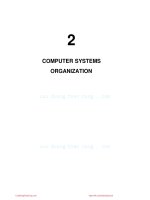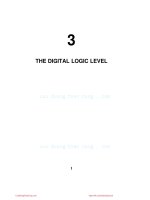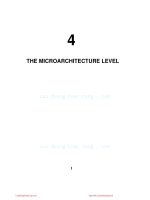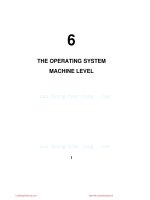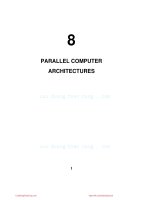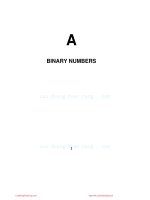kiến trúc máy tính dạng thanh tin general 5 th edition sinhvienzone com
Bạn đang xem bản rút gọn của tài liệu. Xem và tải ngay bản đầy đủ của tài liệu tại đây (9.14 MB, 56 trang )
Computer Architecture
Structured Computer Organization
by A. Tanenbaum, Prentice Hall, 2005
B. W. Wah
ECE 290
Fall 2006
Introductions
1
CuuDuongThanCong.com
/>
Languages, Levels, Virtual Machines
A multilevel machine
3
Tanenbaum, Structured Computer Organization, Fifth Edition, (c) 2006 Pearson Education, Inc. All rights reserved. 0-13-148521-0
Contemporary Multilevel Machines
A six-level computer.
The support method for each level is indicated below it .
4
Tanenbaum, Structured Computer Organization, Fifth Edition, (c) 2006 Pearson Education, Inc. All rights reserved. 0-13-148521-0
2
CuuDuongThanCong.com
/>
Computer Generations
•
Zero’th Generation
Mechanical Computers (1642 – 1945)
•
First Generation
Vacuum Tubes (1945 – 1955)
•
Second Generation
Transistors (1955 – 1965)
•
Third Generation
Integrated Circuits (1965 – 1980)
•
Fourth Generation
Very Large Scale Integration (1980 – ?)
5
Tanenbaum, Structured Computer Organization, Fifth Edition, (c) 2006 Pearson Education, Inc. All rights reserved. 0-13-148521-0
Von Neumann Machine
The original Von Neumann machine.
6
Tanenbaum, Structured Computer Organization, Fifth Edition, (c) 2006 Pearson Education, Inc. All rights reserved. 0-13-148521-0
3
CuuDuongThanCong.com
/>
PDP-8 Innovation – Single Bus
The PDP-8 omnibus
7
Tanenbaum, Structured Computer Organization, Fifth Edition, (c) 2006 Pearson Education, Inc. All rights reserved. 0-13-148521-0
Technological and Economic Forces
Moore’s law predicts a 60-percent annual increase in the
number of transistors that can be put on a chip.
The data points given in this figure are memory sizes, in bits.
8
Tanenbaum, Structured Computer Organization, Fifth Edition, (c) 2006 Pearson Education, Inc. All rights reserved. 0-13-148521-0
4
CuuDuongThanCong.com
/>
Personal Computer
1. Pentium 4 socket
2. 875P Support chip
3. Memory sockets
4. AGP connector
5. Disk interface
6. Gigabit Ethernet
7. Five PCI slots
8. USB 2.0 ports
9. Cooling technology
10. BIOS
A printed circuit board is at the heart of every personal computer. This
figure is a photograph of the Intel D875PBZ board. The photograph is
copyrighted by the Intel Corporation, 2003 and is used by permission.
9
Tanenbaum, Structured Computer Organization, Fifth Edition, (c) 2006 Pearson Education, Inc. All rights reserved. 0-13-148521-0
Example Computer Families
•
•
•
Pentium 4 by Intel
UltraSPARC III by Sun Microsystems
The 8051 chip by Intel, used for embedded systems
10
Tanenbaum, Structured Computer Organization, Fifth Edition, (c) 2006 Pearson Education, Inc. All rights reserved. 0-13-148521-0
5
CuuDuongThanCong.com
/>
Intel Computer Family (1)
The Intel CPU family. Clock speeds are measured in MHz
(megahertz) where 1 MHZ is 1 million cycles/sec.
11
Tanenbaum, Structured Computer Organization, Fifth Edition, (c) 2006 Pearson Education, Inc. All rights reserved. 0-13-148521-0
Intel Computer Family (2)
The Pentium 4 chip. The photograph is copyrighted by the Intel
Corporation, 2003 and is used by permission.
12
Tanenbaum, Structured Computer Organization, Fifth Edition, (c) 2006 Pearson Education, Inc. All rights reserved. 0-13-148521-0
6
CuuDuongThanCong.com
/>
Intel Computer Family (3)
Moore’s law for (Intel) CPU chips.
13
Tanenbaum, Structured Computer Organization, Fifth Edition, (c) 2006 Pearson Education, Inc. All rights reserved. 0-13-148521-0
Computer Systems Organization
7
CuuDuongThanCong.com
/>
Central Processing Unit
The organization of a simple computer with
one CPU and two I/O devices
15
Tanenbaum, Structured Computer Organization, Fifth Edition, (c) 2006 Pearson Education, Inc. All rights reserved. 0-13-148521-0
CPU Organization
The data path of a typical Von Neumann machine.
16
Tanenbaum, Structured Computer Organization, Fifth Edition, (c) 2006 Pearson Education, Inc. All rights reserved. 0-13-148521-0
8
CuuDuongThanCong.com
/>
Instruction Execution Steps
1.
2.
3.
4.
5.
6.
Fetch next instruction from memory into instr. register
Change program counter to point to next instruction
Determine type of instruction just fetched
If instructions uses word in memory, determine where
Fetch word, if needed, into CPU register
Execute the instruction
Go to step 1 to begin executing following instruction
17
Tanenbaum, Structured Computer Organization, Fifth Edition, (c) 2006 Pearson Education, Inc. All rights reserved. 0-13-148521-0
RISC versus CISC
• 1980: RISC has simple instructions that can be executed in
one cycle of a simple data path
• Execute frequently used instructions efficiently and less frequently
used instructions less efficiently
• Wins over CISC that takes multiple and longer cycles to execute a
complex instruction
• May take 4-5 instructions to accomplish a complex operation
• CISC is still predominant in today’s market
• Backward compatibility to early CISC computers
• Starting with 486, Intel CPUs contain a RISC core that executes the
simplest (and typically most common) instructions in a single data
path cycle, while interpreting the more complicated instructions in
the usual CISC way
18
Tanenbaum, Structured Computer Organization, Fifth Edition, (c) 2006 Pearson Education, Inc. All rights reserved. 0-13-148521-0
9
CuuDuongThanCong.com
/>
Design Principles for Modern Computers
•
•
•
•
•
All instructions directly executed by hardware
Maximize rate at which instructions are issued
Instructions should be easy to decode
Only loads, stores should reference memory
Provide plenty of registers
19
Tanenbaum, Structured Computer Organization, Fifth Edition, (c) 2006 Pearson Education, Inc. All rights reserved. 0-13-148521-0
Instruction-Level Parallelism
a)
b)
A five-stage pipeline
The state of each stage as a function of time. Nine clock
cycles are illustrated
20
Tanenbaum, Structured Computer Organization, Fifth Edition, (c) 2006 Pearson Education, Inc. All rights reserved. 0-13-148521-0
10
CuuDuongThanCong.com
/>
Superscalar Architectures (1)
Dual five-stage pipelines with a common instruction fetch unit.
21
Tanenbaum, Structured Computer Organization, Fifth Edition, (c) 2006 Pearson Education, Inc. All rights reserved. 0-13-148521-0
Superscalar Architectures (2)
A superscalar processor with five functional units.
22
Tanenbaum, Structured Computer Organization, Fifth Edition, (c) 2006 Pearson Education, Inc. All rights reserved. 0-13-148521-0
11
CuuDuongThanCong.com
/>
Processor-Level Parallelism (1)
An array of processor of the ILLIAC IV type.
(ILLIAC I in Sept. 1952)
23
Tanenbaum, Structured Computer Organization, Fifth Edition, (c) 2006 Pearson Education, Inc. All rights reserved. 0-13-148521-0
Processor-Level Parallelism (2)
a)
b)
A single-bus multiprocessor.
A multicomputer with local memories.
24
Tanenbaum, Structured Computer Organization, Fifth Edition, (c) 2006 Pearson Education, Inc. All rights reserved. 0-13-148521-0
12
CuuDuongThanCong.com
/>
Cache Memory
The cache is logically between the CPU and main
memory. Physically, there are several possible places it
could be located.
25
Tanenbaum, Structured Computer Organization, Fifth Edition, (c) 2006 Pearson Education, Inc. All rights reserved. 0-13-148521-0
Memory Hierarchies
A five-level memory hierarchy.
26
Tanenbaum, Structured Computer Organization, Fifth Edition, (c) 2006 Pearson Education, Inc. All rights reserved. 0-13-148521-0
13
CuuDuongThanCong.com
/>
Magnetic Disks (1)
A portion of a disk track. Two sectors are illustrated.
27
Tanenbaum, Structured Computer Organization, Fifth Edition, (c) 2006 Pearson Education, Inc. All rights reserved. 0-13-148521-0
Magnetic Disks (2)
A disk with four platters.
28
Tanenbaum, Structured Computer Organization, Fifth Edition, (c) 2006 Pearson Education, Inc. All rights reserved. 0-13-148521-0
14
CuuDuongThanCong.com
/>
Magnetic Disks (3)
A disk with five zones. Each zone has many tracks
and has uneven number of tracks across zones.
29
Tanenbaum, Structured Computer Organization, Fifth Edition, (c) 2006 Pearson Education, Inc. All rights reserved. 0-13-148521-0
RAID (1)
Redundant Array of Inexpensive Disks (1988)
4 bit with error
correction in CM2
RAID levels 0 through 2.
Backup and parity disks are shown shaded.
30
Tanenbaum, Structured Computer Organization, Fifth Edition, (c) 2006 Pearson Education, Inc. All rights reserved. 0-13-148521-0
15
CuuDuongThanCong.com
/>
RAID (1)
Redundant Array of Inexpensive Disks
RAID levels 3 through 5.
Backup and parity disks are shown shaded.
31
Tanenbaum, Structured Computer Organization, Fifth Edition, (c) 2006 Pearson Education, Inc. All rights reserved. 0-13-148521-0
The Processor Level
16
CuuDuongThanCong.com
/>
CPU Chips
The logical pinout of a generic CPU. The arrows indicate input
signals and output signals. The short diagonal lines indicate
that multiple pins are used. For a specific CPU, a number will
be given to tell how many.
33
Tanenbaum, Structured Computer Organization, Fifth Edition, (c) 2006 Pearson Education, Inc. All rights reserved. 0-13-148521-0
Computer Buses (1)
A computer system with multiple buses.
34
Tanenbaum, Structured Computer Organization, Fifth Edition, (c) 2006 Pearson Education, Inc. All rights reserved. 0-13-148521-0
17
CuuDuongThanCong.com
/>
Computer Buses (2)
Examples of bus masters and slaves.
35
Tanenbaum, Structured Computer Organization, Fifth Edition, (c) 2006 Pearson Education, Inc. All rights reserved. 0-13-148521-0
Bus Width
Growth of an Address bus over time.
36
Tanenbaum, Structured Computer Organization, Fifth Edition, (c) 2006 Pearson Education, Inc. All rights reserved. 0-13-148521-0
18
CuuDuongThanCong.com
/>
Bus Clocking
Read timing on a synchronous bus.
37
Tanenbaum, Structured Computer Organization, Fifth Edition, (c) 2006 Pearson Education, Inc. All rights reserved. 0-13-148521-0
Asynchronous Buses
Operation of an asynchronous bus.
38
Tanenbaum, Structured Computer Organization, Fifth Edition, (c) 2006 Pearson Education, Inc. All rights reserved. 0-13-148521-0
19
CuuDuongThanCong.com
/>
Bus Arbitration (1)
(a) A centralized one-level bus arbiter using daisy chaining.
(b) The same arbiter, but with two levels.
39
Tanenbaum, Structured Computer Organization, Fifth Edition, (c) 2006 Pearson Education, Inc. All rights reserved. 0-13-148521-0
Bus Arbitration (2)
Decentralized bus arbitration.
40
Tanenbaum, Structured Computer Organization, Fifth Edition, (c) 2006 Pearson Education, Inc. All rights reserved. 0-13-148521-0
20
CuuDuongThanCong.com
/>
Bus Operations (1)
A block transfer.
41
Tanenbaum, Structured Computer Organization, Fifth Edition, (c) 2006 Pearson Education, Inc. All rights reserved. 0-13-148521-0
Bus Operations (2)
Use of the 8259A interrupt controller.
42
Tanenbaum, Structured Computer Organization, Fifth Edition, (c) 2006 Pearson Education, Inc. All rights reserved. 0-13-148521-0
21
CuuDuongThanCong.com
/>
The Pentium 4
The Pentium 4 physical pinout.
43
Tanenbaum, Structured Computer Organization, Fifth Edition, (c) 2006 Pearson Education, Inc. All rights reserved. 0-13-148521-0
The Pentium 4’s Logical Pinout
Logical pinout of
the Pentium 4.
Names in upper
case are the
office are the
official Intel
names for
individual signals.
Names in mixed
case are groups
of related signals
or signal
descriptions.
44
Tanenbaum, Structured Computer Organization, Fifth Edition, (c) 2006 Pearson Education, Inc. All rights reserved. 0-13-148521-0
22
CuuDuongThanCong.com
/>
Pipelining on the Pentium 4’s Memory Bus
Pipelining requests on the Pentium 4’s memory bus.
45
Tanenbaum, Structured Computer Organization, Fifth Edition, (c) 2006 Pearson Education, Inc. All rights reserved. 0-13-148521-0
The UltraSPARC III (1)
The UltraSPARC III CPU chip.
46
Tanenbaum, Structured Computer Organization, Fifth Edition, (c) 2006 Pearson Education, Inc. All rights reserved. 0-13-148521-0
23
CuuDuongThanCong.com
/>
The UltraSPARC III (2)
The main features of the core of an UltraSPARC III system.
47
Tanenbaum, Structured Computer Organization, Fifth Edition, (c) 2006 Pearson Education, Inc. All rights reserved. 0-13-148521-0
The PCI Bus (1)
Architecture of an early Pentium system. The thicker buses have more
bandwidth than the thinner ones but the figure is not to scale.
48
Tanenbaum, Structured Computer Organization, Fifth Edition, (c) 2006 Pearson Education, Inc. All rights reserved. 0-13-148521-0
24
CuuDuongThanCong.com
/>
The PCI Bus (2)
The bus structure of a modern Pentium 4.
49
Tanenbaum, Structured Computer Organization, Fifth Edition, (c) 2006 Pearson Education, Inc. All rights reserved. 0-13-148521-0
PCI Bus Arbitration
The PCI bus uses a centralized bus arbiter.
50
Tanenbaum, Structured Computer Organization, Fifth Edition, (c) 2006 Pearson Education, Inc. All rights reserved. 0-13-148521-0
25
CuuDuongThanCong.com
/>

